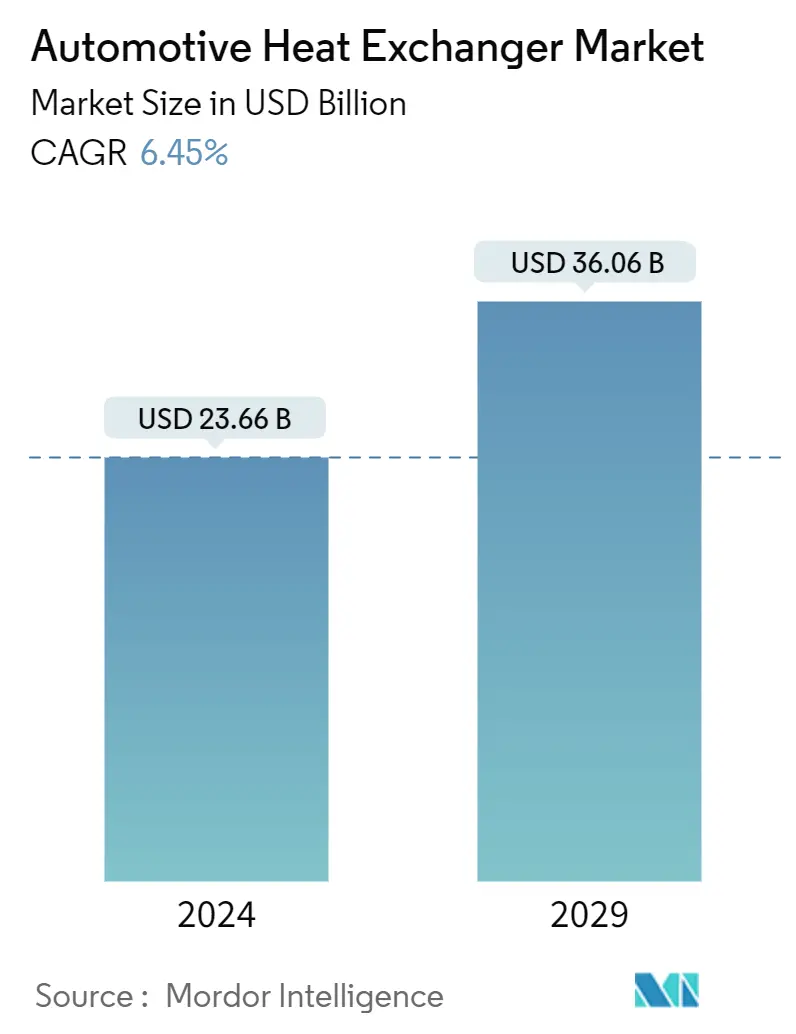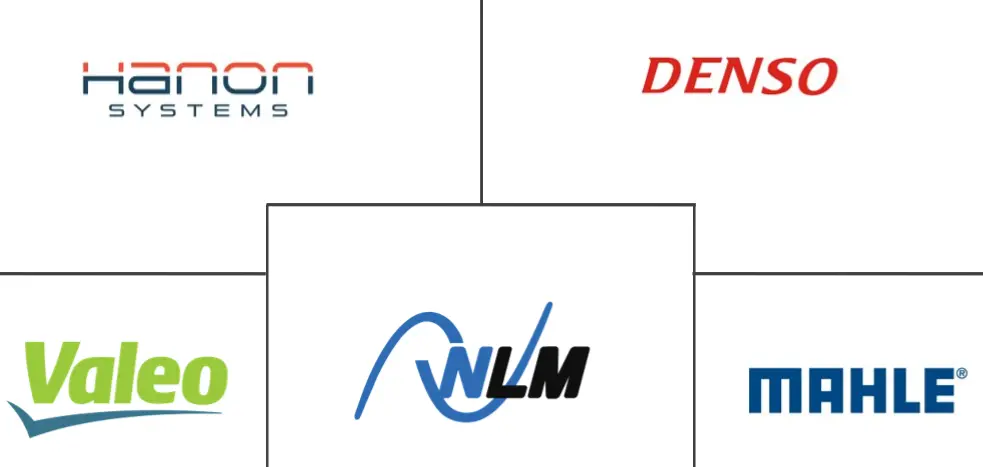Market Size of Automotive Heat Exchanger Industry

| Study Period | 2019 - 2029 |
| Market Size (2024) | USD 23.66 Billion |
| Market Size (2029) | USD 36.06 Billion |
| CAGR (2024 - 2029) | 6.45 % |
| Fastest Growing Market | Asia-Pacific |
| Largest Market | Asia-Pacific |
| Market Concentration | Medium |
Major Players
*Disclaimer: Major Players sorted in no particular order |
Automotive Heat Exchanger Market Analysis
The Automotive Heat Exchanger Market size is estimated at USD 23.66 billion in 2024, and is expected to reach USD 36.06 billion by 2029, growing at a CAGR of 6.45% during the forecast period (2024-2029).
- The COVID-19 pandemic severely impacted the automotive industry across the world in the year 2020. The disruptions in supply chain activities, the interruption in large-scale manufacturing, restrictions on travel, and the declining sales of light vehicles during 2020 hampered the market in focus for the year.
- Over the medium term, increasing production of vehicles and rising demand for passenger vehicles are expected to drive the automotive heat exchanger market. In addition, the rising trend of engine downsizing coupled with advancements in lightweight automotive materials and the rising application of heat exchangers in hybrid and electric vehicles boost demand in the market.
- The rising adoption of electric vehicles has forced traditional heat exchanger systems manufacturers to produce an efficient battery thermal management system and increase their product portfolio. This factor is expected to generate new opportunities for the market during the forecast period. The two major inhibiting factors for the global automotive heat exchanger market are the volatility in the prices of raw materials and the complexity of designing advanced and lightweight heat exchangers.
- The Asia-Pacific region is expected to hold the largest market share in revenue, followed by North America and Europe. Countries such as China and India have witnessed heavy demand and production for passenger vehicles in the Asia-Pacific region. This, in turn, is increasing the application of automotive heat exchangers during the forecast period.
Automotive Heat Exchanger Industry Segmentation
Automotive heat exchange helps in allowing the transfer of heat from one medium to another at varying temperatures. The two mediums contain fluids that flow to each other but are separated by a metal having good heat transfer properties. The hot liquid transfers heat to the freezing liquid as they both pass through the heat exchanger, thus decreasing the hot liquid's high temperature and raising the cold liquid's warmth.
The automotive heat exchanger market is segmented by application (radiators, oil coolers, intercoolers, air conditioning, exhaust gas, and other applications), design type (tube-fin, plate-bar, and other design types), vehicle type (passenger cars and commercial vehicles), powertrain type (IC engine vehicles, electric vehicles, and other vehicles), and geography (North America, Europe, Asia-Pacific, and Rest of the World).
The report offers market size and forecasts for the Automotive heat exchanger market in value (USD) for all the above segments.
| Application | |
| Radiator | |
| Oil Cooler | |
| Intercooler | |
| Air Conditioning | |
| Exhaust Gas | |
| Other Applications |
| Design Type | |
| Tube-Fin | |
| Plate-Bar | |
| Other Design Types |
| Vehicle Type | |
| Passenger Cars | |
| Commercial Vehicles |
| Powertrain Type | |
| IC Engine Vehicles | |
| Electric Vehicles | |
| Other Vehicles |
| Geography | |||||||
| |||||||
| |||||||
| |||||||
|
Automotive Heat Exchanger Market Size Summary
The automotive heat exchanger market is poised for significant growth over the forecast period, driven by increasing vehicle production and the rising demand for passenger vehicles. The market is experiencing a shift due to the trend of engine downsizing and advancements in lightweight materials, which are enhancing the application of heat exchangers in hybrid and electric vehicles. The adoption of electric vehicles is particularly influencing traditional heat exchanger manufacturers to innovate and expand their product offerings, creating new opportunities in the market. However, challenges such as raw material price volatility and the complexity of designing advanced, lightweight heat exchangers pose potential inhibiting factors. The Asia-Pacific region is expected to dominate the market, with countries like China and India leading in demand and production, further boosting the application of automotive heat exchangers.
The global push towards zero-emission vehicles is accelerating the growth of the automotive heat exchanger market, as governments worldwide implement incentives to promote electric vehicle adoption. This shift is expected to significantly impact the market, as the demand for conventional engine cooling components diminishes. The Asia-Pacific region, particularly China and Japan, is anticipated to see substantial growth due to the increasing production of new vehicles and the adoption of hybrid and electric vehicles. The market is moderately consolidated, with major players like DENSO Corporation, MAHLE GmbH, and Valeo focusing on strategic initiatives to enhance their market position. Innovations such as 3D-printed heat exchangers and eco-friendly AC systems are also contributing to the market's evolution, highlighting the ongoing advancements in technology and design.
Automotive Heat Exchanger Market Size - Table of Contents
-
1. MARKET DYNAMICS
-
1.1 Market Drivers
-
1.1.1 Growing Passenger Car Sales
-
-
1.2 Market Restraints
-
1.2.1 Rising Cost of Raw Material Used in Heat Exchangers
-
-
1.3 Industry Attractiveness - Porter's Five Forces Analysis
-
1.3.1 Threat of New Entrants
-
1.3.2 Bargaining Power of Buyers/Consumers
-
1.3.3 Bargaining Power of Suppliers
-
1.3.4 Threat of Substitute Products
-
1.3.5 Intensity of Competitive Rivalry
-
-
-
2. MARKET SEGMENTATION (Market Size in Value - USD billion)
-
2.1 Application
-
2.1.1 Radiator
-
2.1.2 Oil Cooler
-
2.1.3 Intercooler
-
2.1.4 Air Conditioning
-
2.1.5 Exhaust Gas
-
2.1.6 Other Applications
-
-
2.2 Design Type
-
2.2.1 Tube-Fin
-
2.2.2 Plate-Bar
-
2.2.3 Other Design Types
-
-
2.3 Vehicle Type
-
2.3.1 Passenger Cars
-
2.3.2 Commercial Vehicles
-
-
2.4 Powertrain Type
-
2.4.1 IC Engine Vehicles
-
2.4.2 Electric Vehicles
-
2.4.3 Other Vehicles
-
-
2.5 Geography
-
2.5.1 North America
-
2.5.1.1 United States
-
2.5.1.2 Canada
-
2.5.1.3 Rest of North America
-
-
2.5.2 Europe
-
2.5.2.1 Germany
-
2.5.2.2 United Kingdom
-
2.5.2.3 France
-
2.5.2.4 Italy
-
2.5.2.5 Rest of Europe
-
-
2.5.3 Asia-Pacific
-
2.5.3.1 China
-
2.5.3.2 Japan
-
2.5.3.3 India
-
2.5.3.4 South Korea
-
2.5.3.5 Rest of Asia-Pacific
-
-
2.5.4 Rest of the World
-
2.5.4.1 South America
-
2.5.4.2 Middle-East and Africa
-
-
-
Automotive Heat Exchanger Market Size FAQs
How big is the Automotive Heat Exchanger Market?
The Automotive Heat Exchanger Market size is expected to reach USD 23.66 billion in 2024 and grow at a CAGR of 6.45% to reach USD 36.06 billion by 2029.
What is the current Automotive Heat Exchanger Market size?
In 2024, the Automotive Heat Exchanger Market size is expected to reach USD 23.66 billion.

